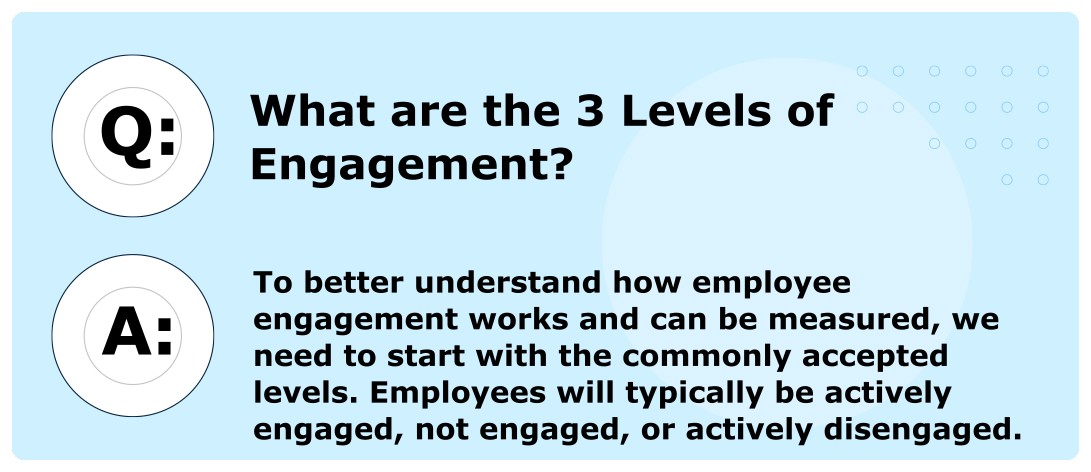What Is Employee Engagement? What Are The Types of Employee Engagement?

The human resources department (HR) of any organization has a lot on its plate. Before sales goals can be exceeded and positive growth can occur, the well-being of the employees on the team needs to be the number one priority.
This can be a lot to handle for HR and upper management. Fortunately, organizations like Milestone offer outsourced HR alternatives to alleviate that pressure. While it is not solely its responsibility, HR takes charge of matters related to employee engagement. That is why we have put together this blog to briefly cover the types and levels of employee engagement so that anyone can identify the importance of employee interactions.
What Is Employee Engagement?
Employee engagement refers to how invested employees are in an organization, it’s mission, and it’s goals. Employee engagement can be seen in how employees feel about their jobs and how invested they are in working towards completing tasks that contribute to the company’s goals.
Why is Employee Engagement Important?

Engaging with employees has implications that can positively or negatively impact your business. If this engagement occurs regularly and changes are made to better the lives of the employees, you will reap benefits like:
Increased Employee Retention
Losing valuable employees is always difficult, but it’s even harder to stomach when it’s for dissatisfaction. When dissatisfaction is a driver of employee turnover, it’s often employees with the best job prospects that leave, in other words, your best talent. . The latest Gallup report showed that around 50% of employees are disengaged. By engaging with employees, you can begin to take action to increase their job satisfaction making it more likely that you retain them.
Increased Productivity
Employees that feel like they are being developed and equipped to do their jobs will in turn be more productive. Engaging with your employees means seeing what you can do to make their work barrier-free.
Less Burnout
With more companies transitioning to a hybrid or entirely virtual work environment, some employers expect their staff to be available more often and work longer. Employee burnout can quickly turn into turnover. Mental and physical exhaustion are on the rise in the workplace, and a straightforward way to combat this issue is by establishing open communication between team members. Create healthy boundaries for employees to come to work each day fresh and energized. These boundaries can range from establishing a regular time off for employees to creating clear and safe environments for questions and any necessary help.
How to Measure Employee Engagement
Understanding that employee engagement is vital to the success of any business is just the beginning. We know why it is essential, but what is the best way to effectively measure employee engagement? There are many different types of employee engagement strategies that can be implemented to improve a business. Let’s look at some examples of employee engagement to understand this process better.
Define Your Goals: Managers should establish specific benchmarks that they need to reach with each employee. These benchmarks can help drive accountability, but for many employees, they can provide a clear roadmap for what success looks like in their job. Having employees understand how to be successful in their role is critical in driving engagement.
Surveys: This method is less personal than a conversation, but the anonymity that comes with surveys can be important to get the unvarnished truth. Using surveys, you can ask more and a wider variety of questions while not taking away time from their work. For example, you can ask questions about job satisfaction, growth opportunities, or alignment questions about company ideals. Done right, surveys can be a cornerstone data point when crafting employee engagement strategies. It’s important to benchmark surveys against yourself. The first survey you conduct is your benchmark, and then you look for improvement in your metrics over the next several surveys.
One-on-One: Sometimes the best way to understand someone is by simply talking to them. If this is not an established practice, an employee may assume they are in trouble. To combat this, one-on-one meetings should be as much of a regular occurrence as possible. Do not just meet for eventful moments, as this will add a level of pressure and stress for the employee with each meeting. These should feel like check-ins to see how they think about their work and place within the company. These meetings can avoid a lot of unnecessary problems due to miscommunications.
To diagnose an existing issue and understand the impact of employee engagement initiatives requires multiple data points so we encourage companies to engage in all three bullets.
What are the 3 Levels of Employee Engagement?

To better understand how employee engagement works and can be measured, we need to start with the commonly accepted levels. Employees will typically be actively engaged, not engaged, or actively disengaged.
Actively Engaged: This is the zone where all employers want to have their employees. While it is impossible to have every single person actively engaged every day, this is what they should strive for. Actively engaged employees are passionate about their work and strive to accomplish the company mission. These employees also exude positive energy that can jump to other employees and departments. They go above and beyond what is typically asked of them to benefit those around them. For example, they may share knowledge with other employees to help with their work. These employees generally have great relationships with management and feel comfortable voicing their opinions in the workplace.
Not Engaged: This zone is where most employees are. At the end of the day, many employees view a job as a meansto provide security for themselves and their family. There will be employees that want to clock in, do their job, and then clock out. These employees tend to have a neutral outlook on the company. The good news is that many of these employees want to be actively engaged but lack the correct interactions from the company.
Actively Disengaged: This last level is not where employees should be.. Employers don’t want their employees here, and employees don’t want to be at this level either. Like the positive energy of actively engaged employees, their negative outlook on the company can spread to other employees and departments. These employees will look for any way to get out of coming to work or do as little as possible. They are also likely to be actively looking for a job elsewhere. The problem is that they did not begin their journey with the company at this level. Through a series of negative interactions, or lack of interactions they are now withdrawn from their work. This level is typically an outlier, but having even one employee here is a red flag.
Even if all your employees claim to be actively engaged, the work is not done. By implementing proper employee engagement practices like company-wide outings, regular one-on-one meetings, and enrichment programs, you can better ensure employees remain or become actively engaged at work.
What are Employee Engagement Strategies?
A successful employee engagement strategy will assist in creating an environment where employees can establish a positive connection with the company. So what are the best strategies you can implement to increase engagement today?
Recognize Success
Shout out your superstar performers. Acknowledging the hard work someone does day in and day out is a super simple and effective strategy. An employee who does not feel recognized will become disengaged and eventually put in less effort. This can be done with a simple meeting at the start of each day or week where top performers are recognized for their work.
Open Communication
Engagement is a two-way street. Make sure all employees have a way to voice their opinions or concerns. If employees recognize that their voices are heard and the company makes changes from their comments, they will feel a sense of ownership in the workplace. There are a variety of different methods and platforms that can faciliate healthy two-way communication.
Cultivate Growth
If employees do not identify clear growth opportunities within your company, they will likely leave after only a brief time. Show your employees that you want them to stay and grow within the company by offering training on skills required for higher-up positions.
These are just three ways that any organization can better engage with employees. Regardless of what strategy or employee engagement model you decide to use, remember that actively engaged associates are happier and more productive.
How To Improve Employee Engagement?
It can actually hamper employee engagement to survey employees and not follow up with an action plan. Employee engagement strategies have to move beyond data collection and diagnosis. Your employee engagement strategy should be about improving employee satisfaction by taking action on programs, policies, and procedures that will increase satisfaction and productivity. Below are just a few possible action-oriented steps a company could take:
Employee Recognition
Even employees that have expressed they do not need praise for their work will find enjoyment in being celebrated for all they do. In a study performed by Deloitte, they found that “High-recognition companies have 31 percent lower voluntary turnover than companies with poor recognition cultures.” Something so simple as recognition at the start of a workday can lead to immense positive change for that employee and the company.
Training and Support
Creating a workplace culture of development and support is fantastic for engagement. Dedicate resources to help employees improve both their hard and soft skills as it relates to their job and life.
Implement Feedback Loops
Feedback around employee engagement isn’t just a one and done. Company culture is in constant change and a small rift or management change can be enough to change the culture and frustrate employees. It’s a good idea to do a company survey at least once a year. The simple act of surveying employees and following through with action can improve employee morale and loyalty.
Employee engagement is a two-way street, so now that we know what it means for management, higher-ups, and business owners, we can dive into the drivers of employee engagement for the actual employees. If you look broadly, most engagement is driven by specific employee desires such as:
Career Growth
Employees want to know that they have a future within an organization. The ability to move and progress through the ranks pushes a lot of employees to succeed in the role they were hired for. If they are not presented with clear avenues to grow, after they acquire skills from your business, they will leave for a different company that offers what you don’t.
Role Clarity
You hear complaints all the time about employees being asked to do work way outside the scope of what they were hired to do. At the same time, it is reasonable for responsibilities to grow and change. A conversation needs to be had about a possible change to the role and sometimes even title and pay. An employee may ask for a bump in pay if they are working far beyond what an individual should be asked to do. When employees have clarity on their position, they can better connect their work’s impact on the business. This clarity will also ensure they can work with better focus and intention.
Independence
When employees are micromanaged, their performance suffers as they worry over any minor detail out of fear of retaliation from their manager. Employees want to engage with their leaders to clearly understand the roles’ goals and expectations to gain a better sense of ownership in their work. When they have the freedom to choose how to manage their time and where to apply their expertise, employees are more likely to be invested in the company and its overall mission.
Milestone Can Help You Master Employee Engagement
Outsourcing your HR offerings to a team like Milestone allows us to take on all those responsibilities so your team can focus on your work. We not only help with employee engagement by implementing data-inspired solutions, but we can also handle the administrative complexities of HR, create HR initiatives, and handle payroll.
Contact us today if you are ready to transform what HR can offer your team!
Related Content

Drivers of Employee Engagement
Unhappy and disengaged employees can cause chaos in a business. Productivity will suffer, goals won’t be met, turnover costs ...

What are the 5 main areas of HR
Smart founders recognize that there is simply one component of their business that they could not exist without: their people. ...

Startup Employee Benefits – Compensation and Health Benefits for Startup Companies
At its core, your startup or small business should include the following benefits: Health Insurance (vision and dental), paid time ...
Stay in the know